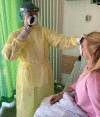[The role of ophthalmology in the COVID-19 pandemic]
- PMID: 32519117
- PMCID: PMC7282201
- DOI: 10.1007/s00347-020-01148-9
[The role of ophthalmology in the COVID-19 pandemic]
Abstract
The severe acute respiratory syndrome coronavirus 2 (SARS-CoV-2) causing coronavirus disease 19 (COVID-19) has led to a worldwide pandemic. This pandemic presents a huge challenge for the healthcare system and also for ophthalmologists. Previous studies and case reports indicated that SARS-CoV‑2 also infects the conjunctiva resulting in conjunctivitis. In addition, infectious virus particles in the tear fluid can be potential sources of infection; however, the detection of SARS-CoV‑2 RNA in the tear fluid has rarely been successful. Although isolated conjunctival involvement is highly unlikely, at the current point in time of the COVID-19 pandemic, practically every patient examined by an ophthalmologist could be infected with SARS-CoV‑2. Therefore, protective and hygiene measures should currently be consistently followed to minimize the risk of spreading the virus. Currently, there are no treatment recommendations for conjunctivitis associated with COVID-19. Tear substitutes might be helpful for symptom relief but there is no evidence for a topical antiviral therapy. In the future ophthalmologists could play a decisive role in the screening of maculopathies that might occur during COVID-19 treatment using chloroquine or hydroxychloroquine.
Das Corona-Virus-Disease-19 (COVID-19) auslösende Severe-Acute-Respiratory-Syndrome-related Coronavirus‑2 (SARS-CoV-2) führte zu einer weltweiten Pandemie und stellt das Gesundheitssystem insgesamt, aber auch die Augenheilkunde vor große Herausforderungen. Bisherige Studien und Fallberichte deuten darauf hin, dass SARS-CoV‑2 auch die Bindehaut infizieren, eine Bindehautentzündung verursachen und dass infektiöse Viruspartikel in der Tränenflüssigkeit potenzielle Infektionsherde darstellen können. Der Nachweis von SARS-CoV-2-RNA in der Tränenflüssigkeit gelang jedoch bisher selten. Auch wenn eine isolierte Bindehautbeteiligung sehr unwahrscheinlich ist, könnte zum gegenwärtigen Zeitpunkt der COVID-19-Pandemie praktisch jeder Patient, der von einem Augenarzt untersucht wird, mit SARS-CoV‑2 infiziert sein. Daher sollten Schutz- und Hygienemaßnahmen aktuell konsequent eingehalten werden, um das Risiko der Verbreitung des Virus zu minimieren. Aktuell gibt es keinerlei Therapieempfehlungen einer COVID-19-assoziierten Konjunktivitis. Tränenersatzmittel könnten zur Symptomlinderung hilfreich sein, eine Evidenz für eine topische antivirale Therapie liegt nicht vor. Dem Augenarzt könnte in Zukunft eine entscheidende Rolle bei dem Screening von Makulopathien zukommen, die im Rahmen einer COVID-19-Therapie mittels Chloroquin oder Hydroxychloroquin auftreten können.
Keywords: Conjunctivitis; Corona-Virus-Disease-19; Coronavirus; Ophthalmology; SARS-CoV-2.
References
Publication types
MeSH terms
LinkOut - more resources
Full Text Sources
Miscellaneous




